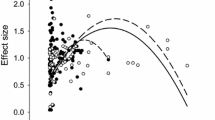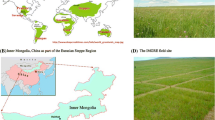Abstract
The 'intermediate disturbance hypothesis' (IDH) predicts maximum species diversity at intermediate levels of disturbance. Disturbance levels are measured by intensity or frequency of disturbance or by the time since disturbance. The IDH has been tested over a wide range of studies and communities with results either accepting or rejecting the hypothesis. The objectives of this study were to determine how observed disturbance response patterns for the same herbaceous plant community are influenced by modelling techniques, particularly in relation to the expression of disturbance gradients, choice of species diversity indices, and time of assessment since disturbance. Response patterns were examined using a multi-factorial disturbance experiment involving grazing (absent and present); fire (absent and present); soil cultivation (none, 5 and 20 cm); and amendment (none, fertiliser, and fertiliser plus clover seeds). Generalized linear models with a b-spline function were used to define response patterns for five different disturbance gradients over a 24-month period using three indices of diversity. Seven basic disturbance response models were recognized ranging from the classical IDH bell-shaped pattern through increasing or decreasing trends, to a no-change model with increasing levels of disturbance. Only 6.7% of all models were consistent with the IDH. The no-change model was found in nearly half the cases investigated and increased in occurrence with time since disturbance. The choice of the disturbance intensity gradient, the species diversity index used and the time of assessment after disturbance significantly influenced the frequency of occurrence of the disturbance response models observed. Consequently, the responses of vegetation to disturbance gradients show many patterns depending on how they are defined and modelled rather than the simple bell-shaped curve as predicted by the IDH, but the ecological mechanisms supporting some of these patterns need to be further investigated.
Similar content being viewed by others
References
Alexander M.E. 1982. Calculating and interpreting forest fire intensities. Canadian Journal of Botany 60: 349-357.
Allen S.E., Grimshaw H.M. and Rowland A.P. 1986. Chemical analysis. In: Moore P.D. and Chapman S.B. (eds), Methods in Plant Ecology. Blackwell Scientific Publications, Carlton, Victoria, USA, pp. 205-344.
Armesto J.J. and Pickett S.T.A. 1985. Experiments on disturbance in old-field plant communities: impact on species richness and abundance. Ecology 66: 230-240.
Aronson R.B. and Precht W.F. 1995. Landscape patterns of reef coral diversity: A test of the intermediate disturbance hypothesis. Journal of Environmental Marine Biology and Ecology 192: 1-14.
Attiwill P.M. 1994. Ecological disturbance and the conservative management of eucalypt forests in Australia. Forest Ecology and Management 63: 301-346.
Beckage B. and Stout I.J. 2000. Effects of repeated burning on species richness in a Florida pine savanna: A test of the intermediate disturbance hypothesis. Journal of Vegetation Science 11: 113-122.
Buckling A., Kassen R., Bell G. and Rainey P.B. 2000. Disturbance and diversity in experimental microcosms. Nature 408: 961-964.
Bureau of Meteorology 2000. Climate Averages. Commonwealth of Australia 2000, Bureau of Meteorology, (10/03/2000).
Burr P. 1996. Newling Weather Station East Armidale NSW. University of New England, Armidale.
Byram G.M. 1959. Combustion of forest fuels. In: Davis K.P. (ed.), Forest Fire: Control and Use. McGraw-Hill, New York, pp. 61-89.
Carr M.R. 1996. PRIMER User Manual (Plymouth Routines in Multivariate Ecological Research). Plymouth Marine Laboratory.
Chalmers A.C. 1996. Plant strategies in herbaceous vegetation in relation to soil disturbance, fertilization and sowing on the Northern Tablelands of NSW. PhD Dissertation, The University of New England, Armidale.
Chilcott C., Reid N. and King K. 1997. Impact of trees on the diversity of pasture species and soil biota in grazed landscapes on the Northern Tablelands, NSW. In: Hale P. and Lamb D. (eds), Conservation Outside Nature Reserves. The University of Queensland, Brisbane, pp. 378-386.
Coffin D.P. and Lauenroth W.K. 1994. Successional dynamics of a semiarid grassland: effects of soil texture and disturbance size. Vegetatio 110: 67-82.
Coffroth M.A. and Lasker H.R. 1998. Population structure of a clonal gorgonian coral: the interplay between clonal reproduction and disturbance. Evolution 52: 379-393.
Collins S.L. 1985. Effects of disturbance on diversity in mixed-grass prairie. Vegetatio 64: 87-94.
Collins S.L. 1987. Interaction of disturbances in tallgrass prairie: a field experiment. Ecology 68: 1243-1250.
Collins S.L. 1992. Fire frequency and community heterogeneity in tallgrass prairie vegetation. Ecology 73: 2001-2006.
Collins S.L. and Glenn S.M. 1997. Intermediate disturbance and its relationship to within-and between-patch dynamics. New Zealand Journal of Ecology 21: 103-110.
Collins S.L., Glenn S.M. and Gibson D.J. 1995. Experimental analysis of intermediate disturbance and initial floristic composition: decoupling cause and effect. Ecology 76: 486-492.
Collins S.L., Knapp A.K., Briggs J.M., Blair J.M. and Steinauer E.M. 1998. Modulation of diversity by grazing and mowing in native tallgrass prairie. Science 280: 745-747.
Connell J.H. 1978. Diversity in tropical rain forests and coral reefs. Science 199: 1302-1310.
Cousins S.H. 1991. Species diversity measurements: Choosing the right index. Tree 6: 190-192.
Egler F.E. 1954. Vegetation science concepts. I. Initial floristic composition, a factor in old-field vegetation development. Vegetatio 4: 412-417.
Fensham R.J., Holman J.E. and Cox M.J. 1999. Plant species responses along a grazing disturbance gradient in Australian grassland. Journal of Vegetation Science 10: 77-86.
Fox B.J. and Fox M.D. 1986. Resilience of animal and plant communities to human disturbance. In: Dell B., Hopkins A.J.M. and Lamont B.B. (eds), Resilience in Mediterranean-type Ecosystems. Dr W. Junk, Dordrecht, pp. 36-64.
Fox J.F. 1981. Intermediate levels of soil disturbance maximize alpine plant diversity. Nature 293: 564-565.
Grime J.P. 1973. Control of species density in herbaceous vegetation. Journal of Environmental Management 1: 151-167.
Gurevitch J. and Collins S.L. 1994. Experimental manipulation of natural plant communities. Tree 9: 94-98.
Harden G.J. (ed.) 1993. Flora of New South Wales. New South Wales University Press, Sydney.
Hiura T. 1995. Gap formation and species diversity in Japanese beech forests: a test of the intermediate disturbance hypothesis on a geographic scale. Oecologia 104: 265-271.
Hobbs R.J. and Hopkins A.J.M. 1990. From frontier to fragments: European impact on Australia's vegetation. Proceedings of Ecological Society of Australia 16: 93-114.
Huston M. 1979. A general hypothesis of species diversity. The American Naturalist 113: 81-101.
Huston M. 1994. Biological Diversity: the coexistence of species on changing landscapes. Cambridge University Press, Cambridge.
Kassen R., Buckling A., Bell G. and Rainey P.B. 2000. Diversity peaks at intermediate productivity in a laboratory microcosm. Nature 406: 508-512.
Kirkpatrick J. 1994. A Continent Transformed: Human Impact on the Natural Vegetation of Australia. Oxford University Press, Oxford.
Kleyer M. 1999. Distribution of plant functional types along gradients of disturbance intensity and resource supply in an agricultural landscape. Journal of Vegetation Science 10: 697-708.
Lean J. and Warrilow D.A. 1989. Simulation of the regional climatic impact of Amazon deforestation. Nature 342: 411-413.
Li J. 2001. Disturbance ecology in temperate pastures on the New England Tablelands of NSW, Australia: herbaceous vegetation, Eucalyptus blakelyi and the environment in relation to anthropogenic influences. PhD Dissertation, University of New England, Armidale.
McIntyre S., Ladiges P.Y. and Adams G. 1988. Plant species-richness and invasion by exotics in relation to disturbance of wetland communities on the Riverine Plain, NSW. Australian Journal of Ecology 13: 361-373.
McIntyre S. and Lavorel S. 1994. Predicting richness of native, rare and exotic plants in response to habitat and disturbance variables across a variegated landscape. Conservation Biology 8: 521-531.
Molino J.F. and Sabatier D. 2001. Tree diversity in tropical rain forests: A validation of the intermediate disturbance hypothesis. Science 294: 1702-1704.
Mooney H.A. and Godron M. (eds) 1983. Disturbance and Ecosystems: Components of Response. Springer-Verlag, Berlin.
Norton B.E. 1971. Grasslands of the New England Tablelands in the nineteenth century. Journal and Proceedings of the Armidale and District Historical Society 15: 1-13.
Padisak J., Reynolds C.S. and Sommer U. (eds) 1993. Intermediate Disturbance Hypothesis in Phytoplankton Ecology. Kluwer, Dordrecht.
Rayment G.E. and Higginson F.R. 1992. Australian Laboratory Handbook of Soil and Water Chemical Methods. Inkata Press, Melbourne.
Schwilk D.W., Keeley J.E. and Bond W.J. 1997. The intermediate disturbance hypothesis does not explain fire and diversity pattern in fynbos. Plant Ecology 132: 77-84.
Sokal R.R. and Rohlf F.J. 1995. Biometry. W. H. Freeman and Company, New York.
Sousa W.P. 1984. The role of disturbance in natural communities. Annual Review of Ecology and Systematics 15: 353-391.
S-PLUS 1999. S-PLUS. Data Analysis Products Division. Math-Soft, Inc., Seattle.
ter Braak C.J.F. and Smilauer P. 1998. CANOCO 4. Centre for Biometry Wageningen, Wageningen.
Till A.R., McArthur G.S. and Rocks R.L. 1984. An automated procedure for the simultaneous determination of sulfur and phosphorus and of radioactivity in biological samples. Proceedings of Sulfur 84., Alberta, Canada.
Tilman D. 1983. Plant succession and gopher disturbance along an experimental gradient. Oecologia 60: 285-292.
Tokeshi M. 1993. Species abundance patterns and community structure. Advances in Ecological Research 24: 111-186.
Venables W.N. and Ripley B.D. 1999. Modern Applied Statistics with S-Plus. Springer-Verlag, New York.
Westoby M., Walker B. and Noy-Meyer I. 1989. Opportunistic management for rangelands not at equilibrium. Journal of Range Management 42: 266-274.
Whalley R.D.B. 1994. State and transition models for rangelands. 1. Successional theory and vegetation change. Tropical Grasslands 28: 195-205.
Whalley R.D.B., Robinson G.G. and Taylor J.A. 1978. General effects of management and grazing by domestic livestock on the rangelands of the Northern Tablelands of New South Wales. Australian Rangeland Journal 1: 174-190.
Wiegand T., Dean W.R.J. and Milton S.J. 1997. Simulated plant population responses to small-scale disturbances in semi-arid shrublands. Journal of Vegetation Science 8: 163-176.
Wilson J.B. 1994. The' Intermediate Disturbance Hypothesis' of species coexistence is based on patch dynamics. New Zealand Journal of Ecology 18: 176-181.
Wootton J.T. 1998. Effects of disturbance on species diversity: a multitrophic perspective. The American Naturalist 152: 803-825.
Worm B., Lotze H.K., Hillerbrand H. and Sommer U. 2002. Consumer versus resource control of species diversity and ecosystem functioning. Nature 417: 848-851.
Zeevalking H.J. and Fresco L.F.M. 1977. Rabbit grazing and species diversity in a dune area. Vegetatio 35: 193-196.
Author information
Authors and Affiliations
Corresponding author
Rights and permissions
About this article
Cite this article
Li, J., Loneragan, W., Duggin, J. et al. Issues affecting the measurement of disturbance response patterns in herbaceous vegetation – A test of the intermediate disturbance hypothesis. Plant Ecology 172, 11–26 (2004). https://doi.org/10.1023/B:VEGE.0000026028.58317.17
Issue Date:
DOI: https://doi.org/10.1023/B:VEGE.0000026028.58317.17




